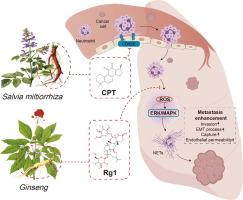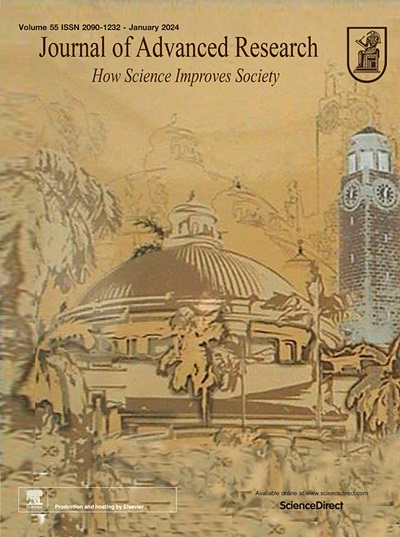通过抑制CD62E依赖性中性粒细胞浸润和NET的形成,协同增强人参-丹参药材组合及其生物成分的抗肿瘤作用
IF 11.4
1区 综合性期刊
Q1 MULTIDISCIPLINARY SCIENCES
引用次数: 0
摘要
引言 人参和丹参联合应用是治疗气滞血瘀型转移性癌症患者的有效方法。本研究通过研究中性粒细胞参与肿瘤血行转移的关键过程,揭示人参和丹参的药理基础。方法构建实验性肺转移模型,比较人参和丹参的抗肿瘤作用。采用RNA测序鉴定关键生物事件和关键靶点,同时检测CD62E的表达和中性粒细胞胞外捕获物(NETs)的释放,以筛选人参和丹参中的有效物质。结果与单味药材相比,人参或丹参能显著减少肿瘤转移,同时减少中性粒细胞向肺部的浸润。丹参的活性成分隐丹参酮(CPT)可通过下调内皮细胞中 E 选择素(CD62E)的表达,抑制中性粒细胞对肺组织的粘附和招募。此外,人参皂苷 Rg1 还能缓解肺组织中 NET 的形成,并逆转 NET 的原发肿瘤效应。结论人参和丹参通过抑制中性粒细胞引发转移级联的早期和晚期阶段,表现出相互增效的抗转移作用。Rg1和CPT分别代表了人参和丹参的协同成分。本文章由计算机程序翻译,如有差异,请以英文原文为准。

Synergistic potentiation of the anti-metastatic effect of a Ginseng-Salvia miltiorrhiza herbal pair and its biological ingredients via the suppression of CD62E-dependent neutrophil infiltration and NET formation
Introduction
The combination of the roots of ginseng and Salvia miltiorrhiza is an effective approach for treating metastatic cancer in patients with Qi stagnation and blood stasis patterns. However, the molecular mechanism underlying the combined use of ginseng and Salvia miltiorrhiza is unknown.Objectives
This study unveils the pharmacological foundation of ginseng and Salvia miltiorrhiza by examining the involvement of neutrophils in the critical process of tumor hematogenous metastasis. Additionally, by employing a reverse pharmacology research model (effect–target–constituent), potential potent components were screened, and the dominant component formulations were determined.Methods
An experimental lung metastatic model was constructed to compare the antitumor effects of ginseng and Salvia miltiorrhiza. RNA sequencing was employed to identify pivotal biological events and key targets, while the detection of CD62E expression and neutrophil extracellular traps (NETs) release was used to screen for effective substances in ginseng and Salvia miltiorrhiza. In addition, a comprehensive array of in vitro and in vivo experiments was conducted to explore the underlying mechanisms and therapeutic significance.Results
Compared with single-herb use, the use of ginseng or Salvia miltiorrhiza significantly reduced tumor metastasis, which was accompanied by reduced neutrophil infiltration into the lungs. Cryptotanshinone (CPT), an active constituent of Salvia miltiorrhiza, can inhibit neutrophil adhesion and recruitment to lung tissue by downregulating the expression of E-selectin (CD62E) in endothelial cells. Moreover, the ginseng −derived ginsenoside Rg1 mitigated the formation of NETs in lung tissues and reversed the protumor effects of NETs. We further explored the efficacy of combination therapy with Rg1 and CPT, which also reduced tumor metastasis in vivo.Conclusion
Ginseng and Salvia miltiorrhiza exhibited a mutual potentiation of the anti-metastatic effect by suppressing both early and late stages of neutrophil-initiated metastasis cascade. Rg1 and CPT represent the synergistic ingredients from ginseng and Salvia miltiorrhiza, respectively.求助全文
通过发布文献求助,成功后即可免费获取论文全文。
去求助
来源期刊

Journal of Advanced Research
Multidisciplinary-Multidisciplinary
CiteScore
21.60
自引率
0.90%
发文量
280
审稿时长
12 weeks
期刊介绍:
Journal of Advanced Research (J. Adv. Res.) is an applied/natural sciences, peer-reviewed journal that focuses on interdisciplinary research. The journal aims to contribute to applied research and knowledge worldwide through the publication of original and high-quality research articles in the fields of Medicine, Pharmaceutical Sciences, Dentistry, Physical Therapy, Veterinary Medicine, and Basic and Biological Sciences.
The following abstracting and indexing services cover the Journal of Advanced Research: PubMed/Medline, Essential Science Indicators, Web of Science, Scopus, PubMed Central, PubMed, Science Citation Index Expanded, Directory of Open Access Journals (DOAJ), and INSPEC.
 求助内容:
求助内容: 应助结果提醒方式:
应助结果提醒方式:


